(1)92反转链表–中等
给你单链表的头指针 head 和两个整数 left 和 right ,其中 left <= right 。请你反转从位置 left 到位置 right 的链表节点,返回 反转后的链表 。

/**
* Definition for singly-linked list.
* struct ListNode {
* int val;
* ListNode *next;
* ListNode() : val(0), next(nullptr) {}
* ListNode(int x) : val(x), next(nullptr) {}
* ListNode(int x, ListNode *next) : val(x), next(next) {}
* };
*/
class Solution {
public:
ListNode* reverseBetween(ListNode* head, int left, int right) {
ListNode* new_head = NULL;
ListNode* next = head;
ListNode* pre_head = NULL;
ListNode* latter_head = NULL;
ListNode* reversed_first_node = NULL;
int count = 1;
while(head){
if(left == right) return head;
else if(count < left){
pre_head = next;
next = next->next;
count += 1;
}
else if (left <= count && count < right){
//逆置的长度如果只有1的话,就不需要逆置
//从最左边开始,没有pre_head
if(left == count) reversed_first_node = next;
if(left != 1) pre_head->next = next->next;
else head = next->next;
next->next = new_head;
new_head = next;
if(left == 1) next = head;
else next = pre_head->next;
count+=1;
}
else if (count == right){
latter_head = next->next;
if (left != 1) pre_head->next = latter_head;
next->next=new_head;
new_head = next;
next = latter_head;
//逆置完成,开始拼接
if (left != 1) pre_head->next = new_head;
reversed_first_node->next = latter_head;
break;
}
}return head;
}
};

(2)160相交链表–简单
给你两个单链表的头节点 headA 和 headB ,请你找出并返回两个单链表相交的起始节点。如果两个链表不存在相交节点,返回 null 。
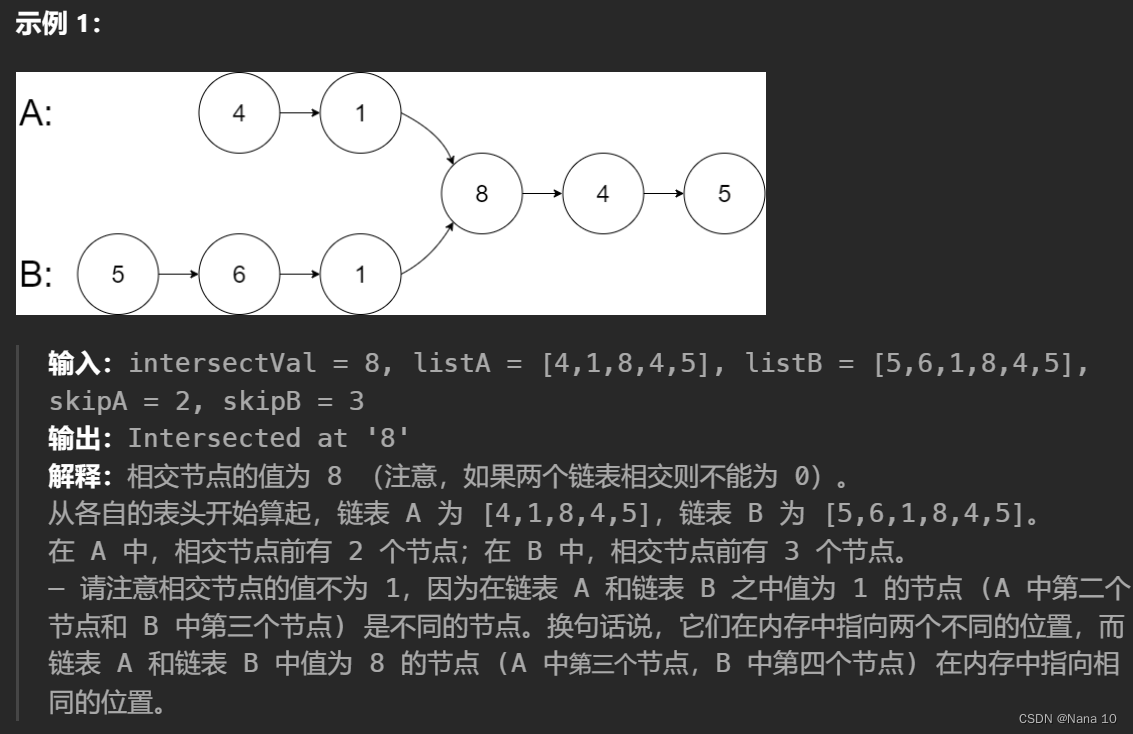
```cpp
/**
* Definition for singly-linked list.
* struct ListNode {
* int val;
* ListNode *next;
* ListNode(int x) : val(x), next(NULL) {}
* };
*/
#include<iostream>
class Solution {
public:
ListNode *getIntersectionNode(ListNode *headA, ListNode *headB) {
if(headA == NULL or headB == NULL) return NULL;
//_a标志从哪个点开始相同
//_b标志正在检查哪个点
ListNode* A_a = headA;
ListNode* A_b = headA;
ListNode* B_a = headB;
ListNode* B_b = headB;
//计算A和B的长度,方便末端对齐
int count_A = 1;
int count_B = 1;
while(A_a){
A_a = A_a->next;
count_A++;
}
while(B_a){
B_a = B_a->next;
count_B++;
}
A_a = headA;
B_a = headB;
if(count_A > count_B){
int len = count_A - count_B;
while(len){
A_a = A_a->next;
len--;
}A_b = A_a;
}
else if(count_A < count_B){
int len = count_B - count_A;
while(len){
B_a = B_a->next;
len--;
}B_b = B_a;
}
cout<< A_a->val<< endl;
cout<< B_a->val<< endl;
//到此,两链表已经末端对齐
while(A_b){
//注意,是数值相等,不是指针相等
if(A_b != B_b){
A_a=A_b->next;
A_b=A_b->next;
B_a=B_b->next;
B_b=B_b->next;
}
else{
A_b = A_b->next;
B_b = B_b->next;
}
}
//cout<< A_a->val<< endl;
return A_a;
}
};

(3)142环形链表二–中等
给定一个链表的头节点 head ,返回链表开始入环的第一个节点。 如果链表无环,则返回 null。
如果链表中有某个节点,可以通过连续跟踪 next 指针再次到达,则链表中存在环。 为了表示给定链表中的环,评测系统内部使用整数 pos 来表示链表尾连接到链表中的位置(索引从 0 开始)。如果 pos 是 -1,则在该链表中没有环。注意:pos 不作为参数进行传递,仅仅是为了标识链表的实际情况。
不允许修改 链表。
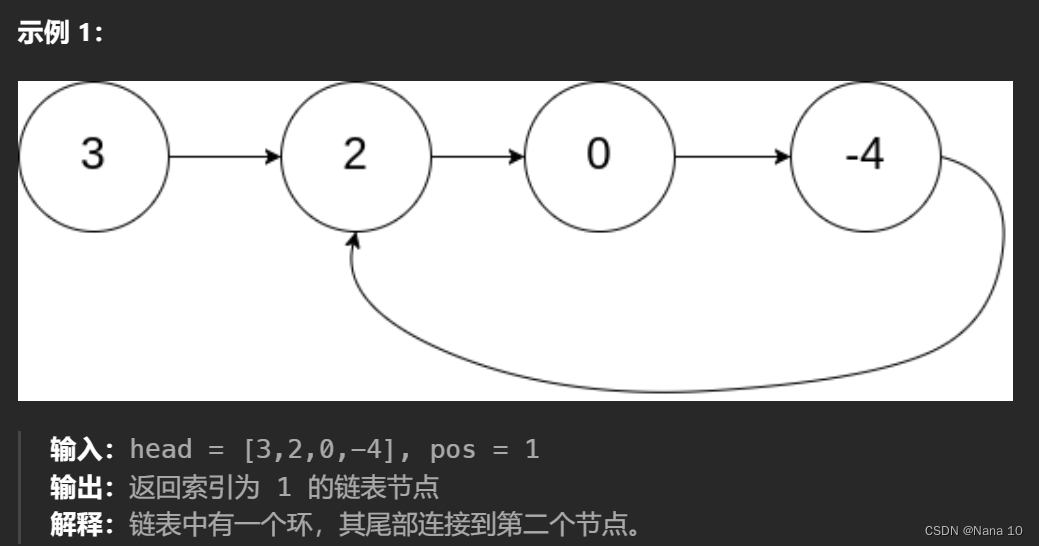
法一:利用集合
#include<iostream>
class Solution {
public:
ListNode *detectCycle(ListNode *head) {
std::set<ListNode*> nodeSet;
if(head == NULL || head->next == NULL ) return NULL;
while(head){
//cout<< head->val << endl;
//在集合的非最后一个元素处找到该节点,则说明已经加过该节点,则该点为循环的起始点
if(nodeSet.find(head) != nodeSet.end())
return head;
nodeSet.insert(head);
head = head->next;
}return NULL;
}
};

法二:快慢指针赛跑
就像跑800,如果有环,快指针肯定能再一次相遇慢指针。
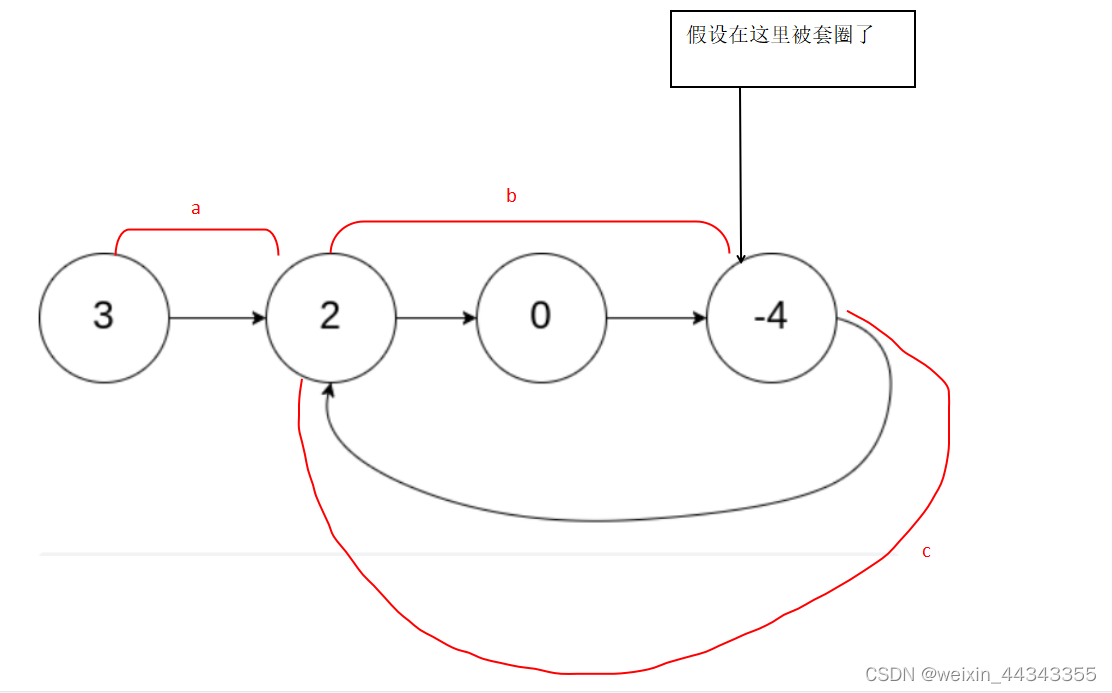
假设快指针每次走两步,慢指针每次走一步
在相同时间内,快指针走的距离是慢指针的两倍
a:起始点到环开始点的距离
b:环开始点到相遇点的距离
c:相遇点到环开始点的距离
快指针跑过的距离:a+b+c+b
慢指针跑过的距离:a+b
所以,a+b+c+b = 2*(a+b)
即:a = c
也就是说,从开始点和快慢指针相遇点一起开始向前走,一次走一格,如果到达了同一个点,即环开始的点
#include<iostream>
class Solution {
public:
ListNode *detectCycle(ListNode *head) {
if(head == NULL || head ->next == NULL) return NULL;
//初始点位指向头结点
ListNode* fastPoint = head->next->next;
if(fastPoint == NULL) return NULL;
cout<< fastPoint->val<< endl;
//fastPoint = ;
ListNode* slowPoint= head->next;
//cout<<slowPoint->val<<endl;
//slowPoint = head;
while(fastPoint){
//找到了相遇点就退出循环
if(slowPoint == fastPoint) break;
//快指针每次走两步,慢指针每次走一步
slowPoint = slowPoint ->next;
if(fastPoint -> next)
fastPoint = fastPoint -> next -> next;
else return NULL;
}
//cout<<slowPoint->val<<endl;
if(fastPoint == NULL) return NULL;//如果走到了尽头,则说明没有环
fastPoint = head;
//*tmpPoint->next = &head;//tmpPoint回到头,开始以慢指针的速度开始走
//两指针未相遇,就一直往前走
while(fastPoint != slowPoint){
fastPoint = fastPoint->next;
slowPoint = slowPoint->next;
}return slowPoint;
}
};
(4)86分隔链表–中等
给你一个链表的头节点 head 和一个特定值 x ,请你对链表进行分隔,使得所有 小于 x 的节点都出现在 大于或等于 x 的节点之前。
你应当 保留 两个分区中每个节点的初始相对位置。
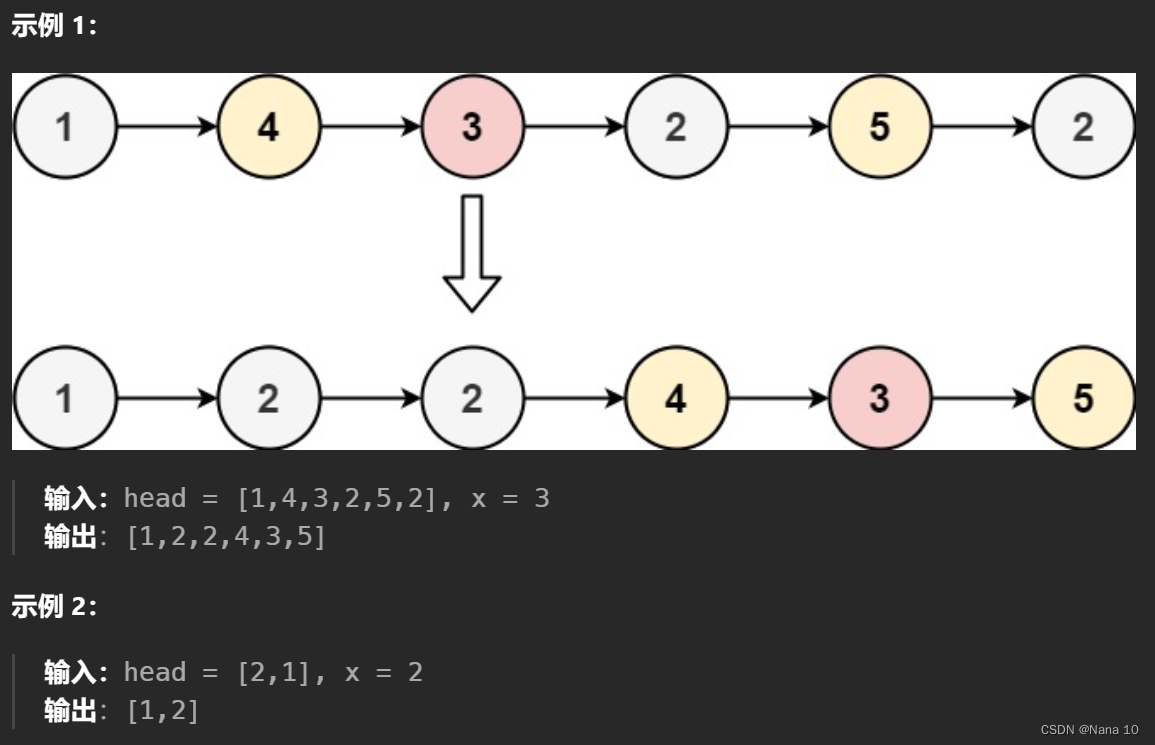
class Solution {
public:
ListNode* partition(ListNode* head, int x) {
if(head == NULL || head->next ==NULL) return head;
//设置两个临时头结点
ListNode lessHead(0);
ListNode moreHead(0);
//对应指针分别指向这两个临时头结点
ListNode* lessptr = &lessHead;
ListNode* moreptr = &moreHead;
while(head){
//比x大的插入到moreptr后
if(head->val>= x){
moreptr->next = head;
moreptr = head;
}
//比x小的插入到lessptr后
else{
lessptr->next = head;
lessptr = head;
}
head = head->next;
}
//两个链表相连
lessptr->next = moreHead.next;
moreptr->next = NULL;
return lessHead.next;
}
};
(5)138复制带随机指针的链表–中等
给你一个长度为 n 的链表,每个节点包含一个额外增加的随机指针 random ,该指针可以指向链表中的任何节点或空节点。
构造这个链表的 深拷贝。 深拷贝应该正好由 n 个 全新 节点组成,其中每个新节点的值都设为其对应的原节点的值。新节点的 next 指针和 random 指针也都应指向复制链表中的新节点,并使原链表和复制链表中的这些指针能够表示相同的链表状态。复制链表中的指针都不应指向原链表中的节点 。
例如,如果原链表中有 X 和 Y 两个节点,其中 X.random --> Y 。那么在复制链表中对应的两个节点 x 和 y ,同样有 x.random --> y 。
返回复制链表的头节点。
用一个由 n 个节点组成的链表来表示输入/输出中的链表。每个节点用一个 [val, random_index] 表示:
val:一个表示 Node.val 的整数。
random_index:随机指针指向的节点索引(范围从 0 到 n-1);如果不指向任何节点,则为 null 。
你的代码 只 接受原链表的头节点 head 作为传入参数。
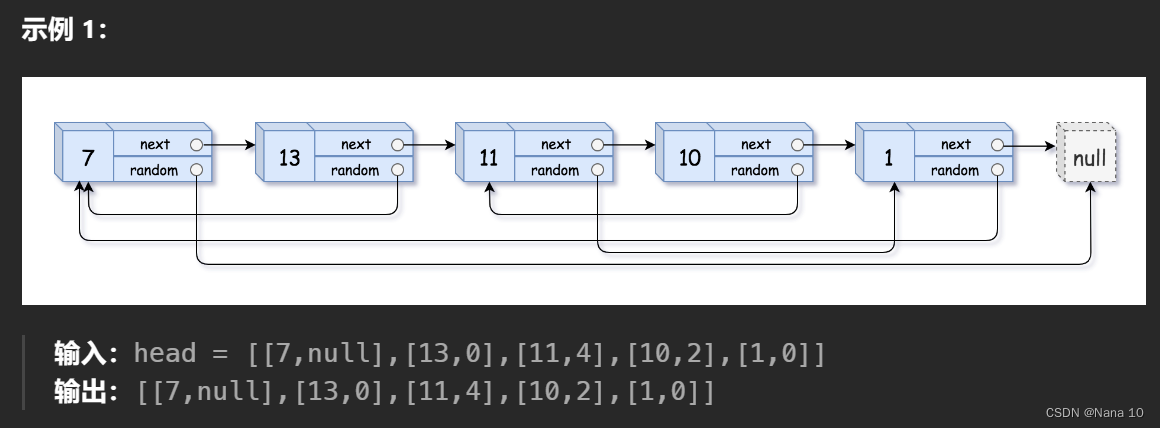
using namespace std;
class Solution {
public:
Node* copyRandomList(Node* head) {
vector<Node*> node_vec;//位置到节点的映射
map<Node*, int> node_map;//地址到位置的映射
Node* ptr = head;
int i = 0;
while(ptr){
//生成新节点,放入列表
node_vec.push_back(new Node(ptr->val));
node_map[ptr] = i;
i++;
ptr = ptr->next;
}
node_vec.push_back(NULL);
ptr= head;
i=0;
while(ptr){
//新节点依次相连
node_vec[i]->next = node_vec[i+1];
if(ptr->random){
//通过map,找出random到位置的映射
int node = node_map[ptr->random];
node_vec[i]->random = node_vec[node];
}
else node_vec[i]->random = NULL;
ptr = ptr->next;
i++;
}
return node_vec[0];
}
};

(6)21合并两个有序链表–简单
将两个升序链表合并为一个新的 升序 链表并返回。新链表是通过拼接给定的两个链表的所有节点组成的。

/**
* Definition for singly-linked list.
* struct ListNode {
* int val;
* ListNode *next;
* ListNode() : val(0), next(nullptr) {}
* ListNode(int x) : val(x), next(nullptr) {}
* ListNode(int x, ListNode *next) : val(x), next(next) {}
* };
*/
class Solution {
public:
ListNode* mergeTwoLists(ListNode* list1, ListNode* list2) {
if(list1 == NULL ) return list2;
if(list2 == NULL ) return list1;
//设置一个头结点
ListNode newnode(0);
//newnode->val = 0;
ListNode* newnodeHead = &newnode;
//取两链表头结点,较小者插入新链表
while(list1&&list2){
if(list1->val <= list2->val){
newnodeHead ->next = list1;
list1 = list1->next;
}
else{
newnodeHead ->next = list2;
list2 = list2->next;
}
newnodeHead = newnodeHead->next;
newnodeHead->next = NULL;
}
//将未空的链表直接接到新链表后
if(list1 !=NULL){
newnodeHead->next = list1;
}
else if(list2 !=NULL){
newnodeHead->next = list2;
}
return newnode.next;
}
};

(7)23合并k个升序表–困难
给你一个链表数组,每个链表都已经按升序排列。
请你将所有链表合并到一个升序链表中,返回合并后的链表。

法一、二
/**
* Definition for singly-linked list.
* struct ListNode {
* int val;
* ListNode *next;
* ListNode() : val(0), next(nullptr) {}
* ListNode(int x) : val(x), next(nullptr) {}
* ListNode(int x, ListNode *next) : val(x), next(next) {}
* };
*/
#include<iostream>
class Solution {
public:
//自定义比较函数
//如果不加static
//非static成员函数在经过编译后编译器会他们添加一个this指针参数
//变成bool cmp(Solution *this, const ListNode* a,const ListNode*b)
//而标准库的sort()函数的第三个cmp函数指针参数中并没有这样this指针参数,因此会出现
//cmp参数和sort()要求的参数不匹配,从而导致:
//error: reference to non-static member function must be called
//static静态类成员函数是不需要this指针的,因此改为静态成员函数即可通过
static bool cmp(const ListNode* a,const ListNode*b){
return a->val < b->val;
}
ListNode* mergeKLists(vector<ListNode*>& lists) {
//if (lists.size() == 0) return NULL;
//else if (lists[0] == NULL&& lists.size() == 1) return NULL;
//假设链表长度为n,有k个链表
//方式1:链表两两合并
//时间复杂度为:(n+n)+(2n+n)+...+((k-1)*n+n) = O(k^2*N)=O(kn*k)
//方式2:放入vector中,将vector排序,再将各个节点相连
//时间复杂度为:O(kn*logkn)
//当kn很大的时候,logkn小于k
vector<ListNode*> points;
ListNode* ptr = NULL;
int listsLength = lists.size();
for(int i = 0; i<listsLength; i++){
ptr = lists[i];
while(ptr){
points.push_back(ptr);
//cout<<ptr->val<<endl;
ptr = ptr->next;
}
}
if(points.size() == 0) return NULL;
std::sort(points.begin(),points.end(),cmp);
listsLength = points.size();
for(int i = 0; i<listsLength-1; i++){
points[i]->next = points[i+1];
}points[listsLength-1]->next = NULL;
return points[0];
}
};

法三:分治
/**
* Definition for singly-linked list.
* struct ListNode {
* int val;
* ListNode *next;
* ListNode() : val(0), next(nullptr) {}
* ListNode(int x) : val(x), next(nullptr) {}
* ListNode(int x, ListNode *next) : val(x), next(next) {}
* };
*/
#include<iostream>
class Solution {
public:
//法三,时间复杂度为O(kn*logkn),链表较长时便可看出效率
ListNode* mergeTowLists(ListNode* a,ListNode*b){
if(a == NULL) return b;
if(b == NULL) return a;
ListNode newhead(0);
ListNode* ptr = &newhead;
while(a&&b){
if(a->val<=b->val){
ptr->next = a;
a = a->next;
ptr = ptr->next;
}
else{
ptr->next = b;
b= b->next;
ptr = ptr->next;
}
}
if(a) ptr->next = a;
else ptr->next = b;
return newhead.next;
}
ListNode* mergeKLists(vector<ListNode*>& lists) {
if (lists.size() == 0) return NULL;
else if (lists.size() == 1) return lists[0];
else if (lists.size() == 2) return mergeTowLists(lists[0],lists[1]);
int mid = lists.size()/2;
vector<ListNode*> sub_list1;
vector<ListNode*> sub_list2;
for(int i = 0; i< mid; i++) sub_list1.push_back(lists[i]);
for(int i = mid; i< lists.size(); i++) sub_list2.push_back(lists[i]);
ListNode* l1 = mergeKLists(sub_list1);
ListNode* l2 = mergeKLists(sub_list2);
return mergeTowLists(l1,l2);
}
};
